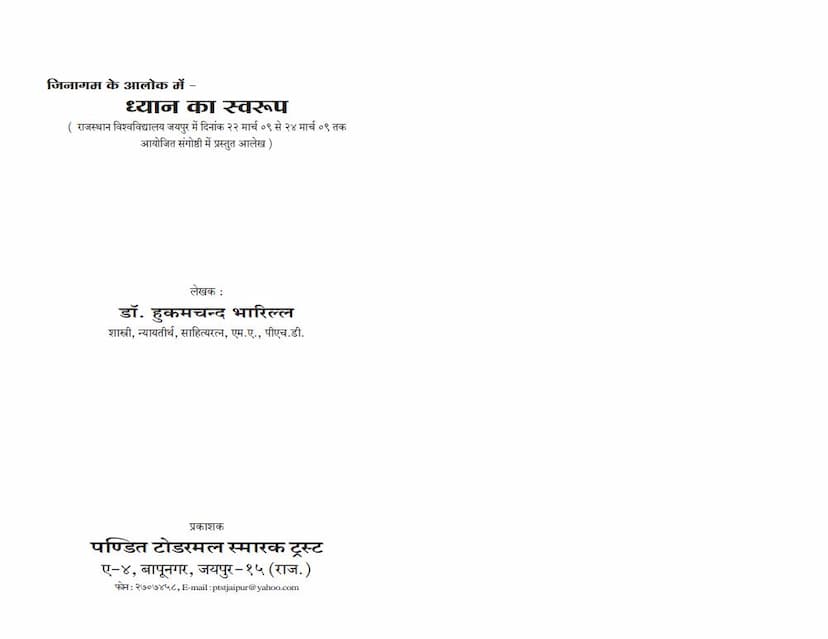Dhyana Ka Swaroop
Added to library: September 1, 2025

Summary
Here's a comprehensive summary of the Jain text "Dhyana ka Swaroop (The Nature of Meditation)" by Hukamchand Bharilla, based on the provided text:
This book, "Dhyana ka Swaroop: Jinagam ke Alok Mein" (The Nature of Meditation: In the Light of Jain Scriptures), delves into the essence and various facets of meditation from a Jain perspective. It emphasizes that true liberation and spiritual advancement are achieved through meditation.
Core Message and Importance of Meditation:
- Path to Liberation: The book asserts that all beings who have attained divinity, equanimity (Vitragata), omniscience (Sarvajnyata), and eternal happiness have done so through the state of self-meditation (Atmadyana). Therefore, self-meditation is indisputably crucial for the path to liberation.
- Universal Symbolism: The text points out that all idols of Arhat Bhagwan in Jain temples are in meditation poses, signifying that the state of meditation is the ultimate religious state. The silence and stillness associated with meditation further underscore its supreme nature.
- Addressing Modern Misconceptions: The author highlights that while meditation is widely discussed today, its true nature and purpose are understood by very few. Many engage in practices that are mistakenly labeled as meditation, missing its profound spiritual implications.
Classification of Meditation:
The book outlines four types of meditation as described in Jain scriptures:
-
Artadhyana (Painful Meditation): This is associated with suffering and sorrow. It has four subtypes:
- Anishtasamyogaj: Suffering due to association with undesirable things.
- Ishtaviyogaj: Suffering due to separation from desirable things.
- Vedanajanya: Suffering due to physical pain or illness.
- Nidanaja: Suffering due to desires or aspirations for future gains (like wealth, progeny, or heaven).
- Impact: Artadhyana, especially in its gross forms, is identified as the cause of rebirth in the animal realm (Tiryanchgati) for the ignorant.
-
Raudradhyana (Fierce Meditation): This is characterized by cruelty and harmful tendencies, leading to pleasure in sinful activities. It also has four subtypes:
- Himsanandi: Pleasure in violence and destructive thoughts.
- Mishanandi: Pleasure in falsehood and deceitful speech.
- Chaurayanandi: Pleasure in theft and dishonest acquisition.
- Parigrahanandi: Pleasure in accumulation and attachment to possessions.
- Impact: Raudradhyana is considered the cause of rebirth in hellish realms (Naraka gati) for the unenlightened.
-
Dharmadhyana (Virtuous Meditation): This is considered the cause of liberation and spiritual progress. It is classified into four types:
- Agyavichaya: Deep contemplation based on the commands of Jain scriptures.
- Apayvichaya (also Upayvichaya): Contemplation on how to avoid the causes of worldly existence (misguided views, knowledge, conduct) and the means to achieve liberation (right faith, knowledge, conduct).
- Vipakavichaya: Reflection on the fruits (vipaka) of karmas and their unfolding.
- Sansthanavichaya: Contemplation on the structure of the Jain cosmos (Urdhvaloka, Adholoka, Madhyaloka).
- Impact: Dharmadhyana is essential for spiritual progress and is accessible even to householders in the current era (Panchamkal). It requires a foundation of right faith (Samyagdarshan).
-
Shukladhyana (Pure Meditation): This is the highest form of meditation, leading directly to omniscience and liberation. It has four stages, and its practice is primarily associated with the Fourth Era (Chaturth Kal) and certain advanced spiritual stages in Jainism, not typically achievable in the current Panchamkal.
- Impact: Shukladhyana leads to the destruction of all karmas and attainment of the liberated state.
Key Distinctions and Practical Advice:
- The Current Era (Panchamkal): The book clarifies that while Shukladhyana is not practically attainable for most in this era, Dharmadhyana is indeed possible and essential.
- The Role of Knowledge: It strongly emphasizes that Dharmadhyana cannot be practiced without studying and understanding Jain scriptures. Ignorance of the scriptures makes it impossible to engage in Agyavichaya, Apayvichaya, Vipakavichaya, and Sansthanavichaya.
- True Meditation vs. Physical Practices: The author criticizes modern interpretations that focus on physical postures (asanas), breathing techniques, or physical well-being as the sole definition of meditation. These are seen as superficial and not the core of true spiritual meditation.
- The Nature of the 'Meditator' and the 'Meditated Object': True meditation involves understanding the true nature of the self (the soul, Jiva) which is distinct from the body and mind. The meditator (Dhyata) must be a being with right faith, and the object of meditation (Dhyeya) is the pure, soul-essence.
- Effortless Attainment: When one develops deep attachment and love for their true self, meditation becomes effortless and spontaneous. It is not something to be forced or learned through external instructions but arises naturally from an inner connection.
- Meditation is Not "Doing": The core of true meditation, particularly in the context of the soul, is not about performing actions (mental, verbal, or physical) but about being and realizing. The soul is naturally in a state of pure consciousness, and the goal is to abide in that state.
- Contrast with Other Practices: The book contrasts the Jain understanding of meditation with practices that focus on bodily health, relaxation, or external phenomena, deeming them insufficient for spiritual liberation.
- Samyagdarshan as a Prerequisite: Right faith (Samyagdarshan) is presented as a foundational requirement for true meditation, as it enables the recognition and acceptance of the true self.
- The Importance of "Samayika": The practice of Samayika is highlighted as a significant form of meditation within the Jain tradition, especially for lay practitioners.
Conclusion:
"Dhyana ka Swaroop" strongly advocates for the study of Jain scriptures to understand and practice true meditation. It aims to correct prevalent misconceptions about meditation, emphasizing that genuine spiritual progress comes from realizing the self, engaging in Dharmadhyana, and ultimately striving for the state of pure consciousness, which is the true essence of Jain meditation. The book encourages readers to shift their focus from external practices to inner realization and understanding of the soul.